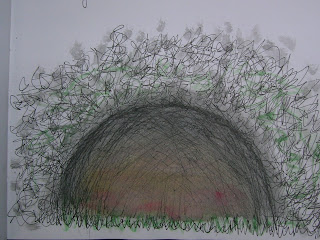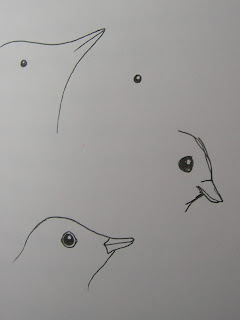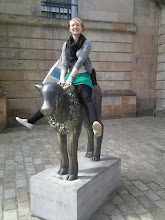This reminded me of some street Art that caught my imagination years ago. Its by an Artist called Louise, she works with her partner Eugene and together they create all sorts of magical things. What was in my mind was some work Louise made by knitting objects and then casting them in plaster, she says of them:
Tuesday, 22 April 2008
3... 2... 1... coming ready or not!
This reminded me of some street Art that caught my imagination years ago. Its by an Artist called Louise, she works with her partner Eugene and together they create all sorts of magical things. What was in my mind was some work Louise made by knitting objects and then casting them in plaster, she says of them:
Things to keep you warm at night

I suppose the Scottish version, although its not an accurate equivalent, would be a bothy. Its temporary in that its used for short period of times by many different people, so it becomes communal but also isolated which is a nice contradiction. It's very basic providing only shelter and not much else, in fact I'm not sure if it wouldn't be more homely in a tent? My favourite thing about Bothy culture is the etiquette, as listed in the link, the fact that there are unwritten rules that you are expected to adhere to. The only way to know them is to be told by someone with more experience than you, that passing down of tradition and information and even location is what makes these things special for me.
Monday, 21 April 2008
Wasp story
At the weekend my mum told me a story about a time in the 70's when she was on a beach in Spain. While she was sunbathing she was watching a little wasp. It was flying backwards and forwards from where there was a skirt lying beside her. This went on for hours before she decided to investigate. When she did lift up the material to find out what the wasp found so interesting she discovered that it was in the process of building itself a little nest. She said it was quite a heavy, navy wool so maybe it made a good shelter from the sun.
Ode to Bill Oddy
With this new interest in nature awareness I'm thinking of getting myself a Bee Box. I have wanted one for a long while so its not strictly a matter of research but i do think it would be facinating to watch a Bee making a home for itself in a little wooden box. Providing a home for something also seems like an interesting thing to do.
Wednesday, 16 April 2008
studio dens and fabric nests
It wasn't exactly time consuming to build but it was fun to snuggle down underneath it. It felt a bit silly at first but as soon as i was underneath with the material drawn across it seemed like it didn't matter anymore. The feeling was almost immediate to, which was surprising, lying down and peering out through the cracks in the sheets i felt like no one could know i was there. It was really pleasant.
I also thought i'd try making different kinds of nests under the table with the left over fabric, because id always rather have a home made of c omfortable material than twigs and mud or bits of newspaper. They turned out to be less like nests and more like hammocks or little fabric wombs. There are some birds who make womb like nests but these reminded me more of something like a kangaroo pouch.
Nest building attempt one
The extremley informative Protect and Survive manual
A handy lists of supplies to keep handy for the 48hours of radiation that follows a bomb drop , it includes such things as: Torches, spare batteries, matches, toilet articles, change of clothes, first aid, dry sand, Vaseline , notebooks for messages, cleaning materials, toys and a mechanical clock. It tells you how to store drinking water safely, how to go to the bathroom, how to protect against fire, how to deflect the blast by painting the windows white and, of course, how to bury your dead.
The further into the booklet i got though the sadder it seemed. This illustration in particular makes the people look so pathetic.
I suppose I can find it laughable because I'm lucky enough never to have experienced this kind of threat. And if you are living this day to day when the government tells you to do something to keep yourself safe, with no other option, there's a good chance your going to do what they say. It does seem an awful lot like scaremongering at best and at worst miss information for the hopeless.
Anyway, it was definatly an intresting read, I'm glad I came a cross it and i think it c overs quite a few of the points in my research too.
Monday, 14 April 2008
Dens, Forts, Nooks and Crannies
Or making a nook under a hedge in the back court... that was particularly good fun as there where always rocks and tree roots to use as furniture. The backgarden den also has more in commen with the nests I've been looking at and the thought of making a little woven enclosure out and about somewhere is quite exciting. like a nest for memories.
I'm still looking for some more detailed information, on artists or otherwise, about why all children do this and why it is such a comforting thing? I think it could be an interesting thing to take further, or just to understand a little better for myself.
Still Human Still Here
while looking for some more information as a follow up to the last post, I found this campaign from Amnesty International, there is also a short documentary on the subject from Nick Broomfield on this link
http://www.amnesty.org.uk/content.asp?categoryID=10398
paraSITE

http://www.michealrakowitz.com
It makes me wonder how different your concept of a home becomes when your stripped of almost everything you know?

There's no place home *click click click*

What do you need to make yourself feel settled and secure?
I'm not sure what this means for me, it seems obvious to say that it is made from a feeling rather than anything else but that doesn't seem to be specific enough for the things I've been looking at. I'm taken with the idea that once you leave home, the place you grew up in, that there's no longer a home for you to return to. The little spell of comfort that you had is broken and it becomes up to you to recreate it for yourself and most people, i imagine, use things to make this real again.
It reminds me of something i read about Simone De Beauvoir a long time ago, it was a passage in Nausea by Jean-Paul Sartre. He was writing about how she moved around so much and yet still made every place she stayed seem like home. She did this by carrying with her suitcases full of her most important possessions, scarves, books, pictures and trinkets. At the time I thought this seemed like quite a romantic idea but looking back at it now it seems a little bit sad. To make everywhere you go exactly the same seems limiting to me, not only are you missing out on experiencing the new you are also never properly recreating or capturing the place you miss?

Sunday, 13 April 2008
Pepe Espaliú
"The empty cage is not the prison but the body itself"
Another series of performances that seek to capture these elusive emotional states, took place with the artist being carried down the street by two members of the public. taking reference in the bible stories of Jesus carrying peter across the water. It makes a childhood game into a meaningful communication, where the carrier becomes the carried.
Friday, 11 April 2008
That Nesting Instinct

To start this project i've begun looking at ideas of saftey and security. It began when two weeks ago i found a nest in the hedge outside my bedroom window, it contained two chirrping baby birds and a mother bird who looked awfully unhappy to see me sticking my nose into thier home. She snuggled down on the little chicks so all you could see peering from underneath was one little beak nuzzling about. The chicks have since flown away and the nest seems to be abandoned but it still looks beautifull, especially as it seems secret. I dont think anyone else would know that its there?
Trying to build a replica little nest really appeals to me i found these instructions: http://www.learner.org/jnorth/tm/robin/BuildNest.html
1. Find a suitable building site
The site should be protected from sun, wind and rain. It can be anywhere from ground to treetop in height; the site must be on something sturdy enough to anchor the nest securely in place. You don't want your nest to fall off!
Your nest should also be very close to a good feeding spot so you can easily find worms while keeping an eye on it, and it shouldn't be too far from water.
Choose a spot that is hard for predators to see. Remember, you and your eggs and babies will be sitting here for the next 5 weeks, so be careful to pick a spot that's safe, cool, and comfortable.
2. Gather materials
Grass fibers: Collect about 350 dead grasses and twigs that are about 6 inches long. (The pile should weigh about 135 grams.)
Soft mud: After a soaking rain, collect mouthfuls of mud in your beak and travel back and forth to your nest site a few hundred times. (If you happen to be a person rather than a robin, you might substitute your hands for a beak to collect the mud, but don't forget that it takes a pair of robins hundreds of visits to build the nest!)
3. Build!
Weave the grasses together, cementing them to each other and to the supporting branch or windowsill with mud.
Next, use your tummy to shape the nest into a perfect baby cradle.
Finally, line the inside with the softest grasses and hairs you can find so the eggs will stay warm and not get pierced by any twigs or sharp grass edges. The nest must be tight and snug enough to cradle the eggs and hold in your warmth, but large enough to hold four or even five BIG nestlings.
This idea of sneaking yourself into a small space to keep yourself and the people you love safe got me thinking about how we all do this everyday. We make safe spaces for ourselves in our homes, bedrooms, cars, relationships, clothing, even in our own personal space and the bounderies we create. I noticed how we do this at the start of every project in the studio, we all select our little bit of wall in whats really just a big white box and make it our own, fill it with personal things important to us and what we are exploring. its a comforting thing to do and i think there are times when we all feel insecure and want to curl ourselves up into a tiny corner.







































